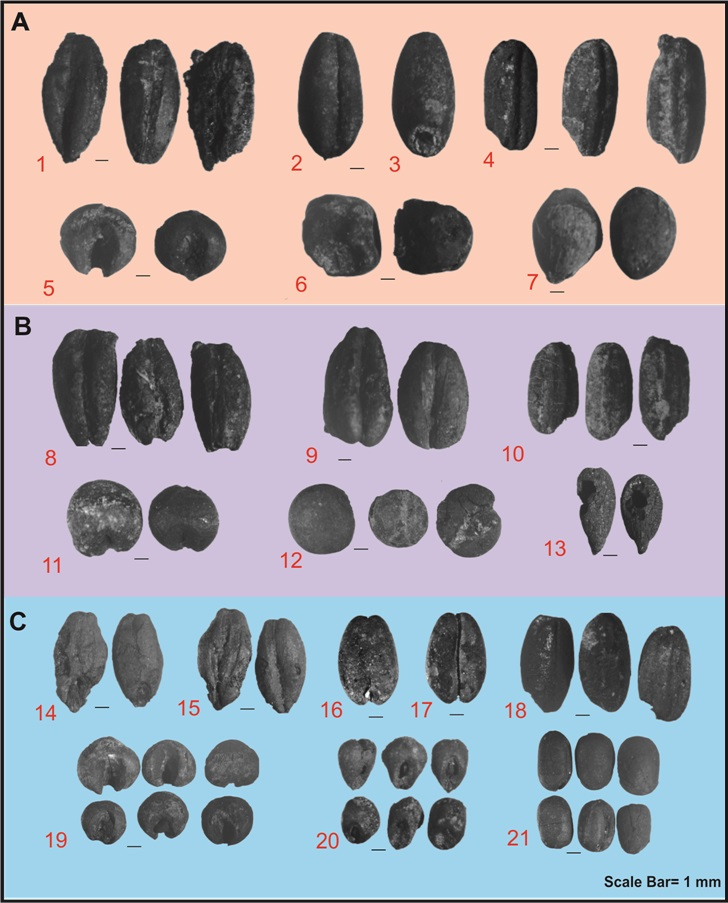Past to Guide in Adopting Climate Changes

2000-year-old archaeological, botanical and isotopic data in India provide clues to future climate adaptations
The relationship between historical climate change and past agricultural production contributes to a better understanding of the impacts of projected climate change by providing empirical data for resilient human responses.
A study in this regard by the Indian scientists has explored the periods of dynastic transitions and crop production at the urban site of Vadnagar, in semi-arid northwest India through several climate events, generally characterised by weakening summer monsoon precipitation during the Late Holocene.
Artefacts from the site present an unbroken sequence of seven successive cultures from the first century BCE to the nineteenth century CE. Archaeobotanical data indicate the sufficient water availability during the Historic and Medieval periods, allowing crop production dominated large-grained cereals (C3 plants). However, during the Post-Medieval period (ca.1300−1850 CE) a resilient crop economy based on small-grained cereals (C4 plants) dominated, representing a human adaptation to prolonged weakening of monsoonal precipitation.
Isotopic and phytolith data at the site present a clear signal of changing local environmental conditions over two millennia, consistent with regional palaeoclimate records, providing and interpretive context for agricultural evidence at Vadnagar.
The site of Vadnagar in semi-arid Gujarat region witnessed mild to intense monsoon precipitation during Historic and Medieval periods respectively and post mediaeval period (1300-1900 CE; LIA) bore a resilient crop economy based on small-grained cereals (millets; C4 plants) reflecting human adaptation in response to a protracted weakening of the summer monsoon, according to a new study. The study can help inform strategies to future climate change adaptation to it.
Owing to the critical importance of the ISM in the Indian context, its variability in the past and its influence on the early civilizations has not been studied extensively in archaeological context. Further, the rarity of Historic sites, systematic excavations, and multi-disciplinary work in the subcontinent, obscure the impact of distinct climate anomalies in the past. The intensity of the ISM precipitation varies over the Indian landmass, due to the variations in latitude, altitude, and distance from the sea.

Scientists have been tracing historical data on variations of rainfall and its consequences as such studies on changing cropping pattern, vegetation, and cultural development, during the last 2000 yrs. provide clues for past human response to climate change and important lessons for modern societies in exploring possible strategies to future climate change.
A team of researchers from Birbal Sahni Institute of Palaeosciences (BSIP), an autonomous institution of Department of Science and Technology presented a circa (ca) 2500-year human occupation sequence spanning multiple environmental changes at the Vadnagar archaeological site based on archaeological, botanical, and isotopic data.
The multiproxy study published in Quaternary Science Advances explores the periods of dynastic transitions and crop harvesting in semi-arid northwest India during past Northern Hemisphere climate events, namely the Roman Warm Period (RWP, 250 BCE-400 CE), Medieval Warm Period (MWP, 800 CE-1300 CE) and Little Ice Age (LIA, 1350 CE-1850 CE).
The data from the site indicate that food production was maintained, even during climate deterioration. It was based on archaeobotanical knowledge which combines botanical knowledge with the archaeological material. Besides macro botanical remains, micro botanical (phytolith), and isotope and radiocarbon dating of the grains and charcoal were also included in the study. Archaeological settlements have a potential to play a significant role as the region is known to respond to sharp climatic (monsoonal) changes owing to location in the north-western periphery of southwest monsoon activity in India. Further, plants used by ancients provide direct evidence of their choices, activities, and ecological conditions.
The combined analysis has enabled an assessment for diversification of food crops and resilient socio-economic practices during the past two millennia in the wake of increasing precipitation and period of weakened monsoon (drought) that affected globally. The results have implications for studies linking past climate changes and historic period famines, indicating that these were in part driven by institutional factors, rather than climate deterioration alone.
In sum, despite long-term reduction in summer humidity, Indian scientists have argued that an adaptable agricultural package coupled with suitable water management systems allowed for the resilience of the urban settlement at Vadnagar.

Figure.1 (A) Map of North Gujarat, showing climatic zones, (adopted from Pokharia et al., 2020). (B) Location of Vadnagar in the Eastern Rocky foothill zone of Gujarat. (C) Grid layout of excavated trenches at Vadnagar. (D) 14.10 m deep cuttings in the trench of the Locality B showing layers of cultural deposits in Vadnagar. (E) Locality C section along the fortification wall.


Figure. 2 Stratigraphy at the site Vadnagar from historic phase to the Post Medieval phase of locality C showing cultural phases, radiocarbon dates, sample collection (red dot) from each layers and numismatic records.

Figure. 3 Charred crop remains recovered from the cultural layers of archaeological site Vadnagar, Gujarat: (A) Crop remains recovered from Historic Phase (200 BCE-500 CE); (1) Hordeum vulgare; (2) Triticum aestivum (Ventral); (3) Triticum aestivum (Dorsal); (4) Oryza sativa; (5) Sorghum bicolor; (6) Lathyrus sativus; (7) Gossypium sp.; (B) Crop remains recovered from Medieval Phase (500 CE-1300 CE); (8) Hordeum vulgare; (9) Triticum aestivum; (10) Oryza sativa; (11) Sorghum bicolor; (12) Lens culinaris; (13) Linum usitatissimum; (C) Crop remains recovered from Post- Medieval Phase (1300 CE-1900 CE); (14) Hordeum vulgare (Dorsal); (15) Hordeum vulgare (Ventral); (16) Triticum aestivum (Dorsal); (17) Triticum aestivum (Ventral); (18) Oryza sativa; (19) Sorghum bicolor; (20) Pennisetum glaucum; (21) Vigna radiata.

